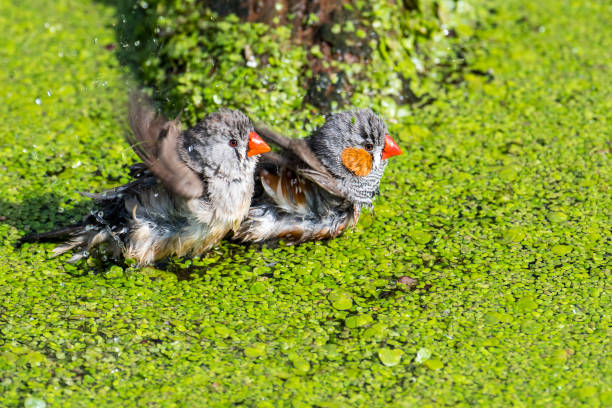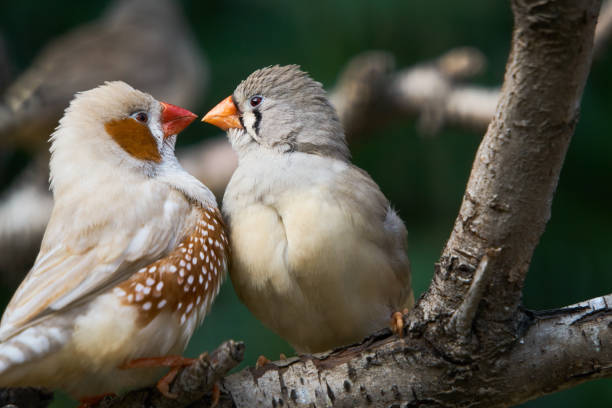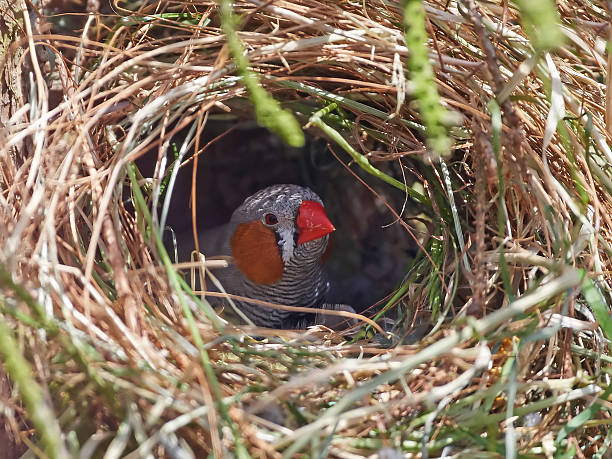Table of Contents
Scientific Classification
| Kingdom | Animalia |
| Phylum | Chordata |
| Class | Aves |
| Order | Passeriformes |
| Family | Estrildidae |
| Genus | Taeniopygia |
| Species | Taeniopygia guttata |
| Scientific Name | Taeniopygia guttata |
Description
The Zebra Finch is a small, energetic bird celebrated for its vivid colors and beautiful song. It typically measures about 4 inches (10 cm) long and weighs around 10-12 grams. Males are easily recognized by their bright orange beaks, black-and-white striped throats, and chestnut-colored cheeks. In contrast, females are more subdued in color and have lighter beaks. Their tails feature a striking black and white pattern, reminiscent of a zebra, which is how they got their name.

Distribution
Zebra Finches are native to Australia and can be found throughout most of the continent. However, they do not inhabit the dense tropical rainforests on the east coast. These birds have also made appearances in various countries, including the United States, Portugal, and Indonesia, largely due to their popularity as pets and in aviaries.
Habitat
Zebra Finches flourish in dry, arid habitats such as grasslands, open woodlands, and savannas. They are highly adaptable and often inhabit areas near humans, particularly on farms and in urban gardens where food and water are readily available.
Diet
Zebra Finches mainly eat seeds, especially those from grasses and small shrubs. Their beaks are specially adapted to crack open seed husks with ease. During the breeding season, they also include small insects such as ants and termites in their diet, which provide essential protein for their developing chicks.
Behavior
Zebra Finches are very social creatures that thrive in flocks. Males tend to be more vocal than females, using soft chirps and high-pitched songs to communicate. Their songs are intricate and can vary from one bird to another, often learned from their fathers. These birds are diurnal, meaning they are active during the day, and they dedicate much of their time to foraging and engaging with their flock.

Lifespan
Zebra Finches typically have a lifespan of 3 to 5 years in the wild. However, with proper care in captivity, they can live significantly longer, often reaching 7 to 10 years. This extended lifespan is largely attributed to a consistent food supply and protection from predators.
Reproduction and Lifecycle
Zebra Finches are known for their monogamous nature, forming strong pair bonds that can last a lifetime. They can mate throughout the year, depending on the availability of food. The female typically lays between 4 to 6 eggs, which both parents incubate for around two weeks. After hatching, the chicks are fed regurgitated food and leave the nest after about 18 to 21 days. By the time they reach 3 months of age, young Zebra Finches attain sexual maturity and are ready to seek out their own mates.

Predators
In the wild, Zebra Finches face threats from various birds of prey, such as hawks and falcons. Additionally, snakes and small mammals, including rodents, may target their eggs and nestlings. To protect themselves from these dangers, they construct their nests in dense shrubs or high up in tree branches.
Adaptations
Zebra Finches have developed several amazing adaptations. These help them thrive in tough environments:
Efficient Water Conservation: They can last a long time without drinking water. Instead, they get moisture from their food.
Rapid Reproduction: They breed year-round. This keeps their population steady, even when conditions change.
Social Bonding: Flocking together helps them spot predators and find food better.
Vocal Learning: They can mimic and learn complex songs. This helps them communicate and attract mates.
Conservation Status
Zebra Finches are currently classified as a species of Least Concern by the IUCN Red List. Their populations remain stable thanks to their adaptability and broad distribution. However, habitat destruction and climate change pose long-term threats. Conservationists monitor their status closely. Additionally, their popularity in the pet trade results in frequent breeding in captivity, which helps maintain their presence in aviculture.
The Zebra Finch demonstrates remarkable resilience and adaptability among bird species. With their distinctive markings, cheerful songs, and friendly demeanor, they have become favorites among bird enthusiasts and researchers alike. These small birds, whether found in the wild or kept as pets, continue to captivate us with their intelligence.



